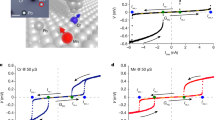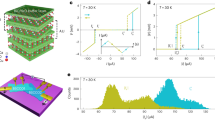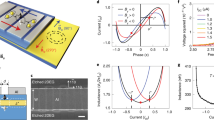Abstract
Thermoelectric effects in metals are typically small due to the nearly perfect particle–hole symmetry around their Fermi surface. Furthermore, thermo-phase effects and linear thermoelectricity in superconducting systems have been identified only when particle–hole symmetry is explicitly broken, since thermoelectric effects were considered impossible in pristine superconductors. Here, we experimentally demonstrate that superconducting tunnel junctions develop a very large bipolar thermoelectricity in the presence of a sizable thermal gradient thanks to spontaneous particle–hole symmetry breaking. Our junctions show Seebeck coefficients of up to ±300 μV K–1, which is comparable with quantum dots and roughly 105 times larger than the value expected for normal metals at subkelvin temperatures. Moreover, by integrating our junctions into a Josephson interferometer, we realize a bipolar thermoelectric Josephson engine generating phase-tunable electric powers of up to ~140 nW mm–2. Notably, our device implements also the prototype for a persistent thermoelectric memory cell, written or erased by current injection. We expect that our findings will lead to applications in superconducting quantum technologies.
This is a preview of subscription content, access via your institution
Access options
Access Nature and 54 other Nature Portfolio journals
Get Nature+, our best-value online-access subscription
$29.99 / 30 days
cancel any time
Subscribe to this journal
Receive 12 print issues and online access
$259.00 per year
only $21.58 per issue
Buy this article
- Purchase on Springer Link
- Instant access to full article PDF
Prices may be subject to local taxes which are calculated during checkout




Similar content being viewed by others
Data availability
All data that support the plots within this paper and other findings of this study are available from the corresponding authors upon reasonable request.
References
Ashcroft, N. & Mermin, N. Solid State Physics (Holt-Saunders, 1976).
Abrikosov, A. A. Fundamentals of the Theory of Metals (Courier Dover Publications, 2017).
Mott, N. F. & Jones, H. The Theory of the Properties of Metals and Alloys (Dover Publications, 1958).
Mamin, H. J., Clarke, J. & Van Harlingen, D. J. Charge imbalance induced by a temperature gradient in superconducting aluminum. Phys. Rev. B 29, 3881–3890 (1984).
Meissner, W. Z. Das elektrische verhalten der metalle im temperaturgebiet des flüssigen heliums. Z. Ges. Kälte Industrie 34, 197 (1927).
Ginzburg, V. On the thermoelectric phenomena in superconductors. Zh. Eksp. Teor. Fiz. 14, 134 (1944).
Shelly, C. D., Matrozova, E. A. & Petrashov, V. T. Resolving thermoelectric ‘paradox’ in superconductors. Science 2, e1501250 (2016).
Guttman, G. D., Nathanson, B., Ben-Jacob, E. & Bergman, D. J. Thermoelectric and thermophase effects in Josephson junctions. Phys. Rev. B 55, 12691–12700 (1997).
Giazotto, F., Heikkilä, T. T. & Bergeret, F. S. Very large thermophase in ferromagnetic Josephson junctions. Phys. Rev. Lett. 114, 067001 (2015).
Kleeorin, Y., Meir, Y., Giazotto, F. & Dubi, Y. Large tunable thermophase in superconductor – quantum dot – superconductor Josephson junctions. Sci. Rep. 6, 35116 (2016).
Smith, A. D., Tinkham, M. & Skocpol, W. J. New thermoelectric effect in tunnel junctions. Phys. Rev. B 22, 4346–4354 (1980).
Machon, P., Eschrig, M. & Belzig, W. Nonlocal thermoelectric effects and nonlocal Onsager relations in a three-terminal proximity-coupled superconductor-ferromagnet device. Phys. Rev. Lett. 110, 047002 (2013).
Ozaeta, A., Virtanen, P., Bergeret, F. S. & Heikkilä, T. T. Predicted very large thermoelectric effect in ferromagnet-superconductor junctions in the presence of a spin-splitting magnetic field. Phys. Rev. Lett. 112, 057001 (2014).
Kolenda, S., Wolf, M. J. & Beckmann, D. Observation of thermoelectric currents in high-field superconductor-ferromagnet tunnel junctions. Phys. Rev. Lett. 116, 097001 (2016).
Bergeret, F. S., Silaev, M., Virtanen, P. & Heikkilä, T. T. Colloquium: nonequilibrium effects in superconductors with a spin-splitting field. Rev. Mod. Phys. 90, 041001 (2018).
Linder, J. & Robinson, J. W. A. Superconducting spintronics. Nat. Phys. 11, 307–315 (2015).
Virtanen, P. & Heikkilä, T. T. Thermopower induced by a supercurrent in superconductor–normal-metal structures. Phys. Rev. Lett. 92, 177004 (2004).
Blasi, G., Taddei, F., Arrachea, L., Carrega, M. & Braggio, A. Nonlocal thermoelectricity in a superconductor–topological-insulator–superconductor junction in contact with a normal-metal probe: evidence for helical edge states. Phys. Rev. Lett. 124, 227701 (2020).
Tan, Z. B. et al. Thermoelectric current in a graphene Cooper pair splitter. Nat. Commun. 12, 138 (2021).
Eom, J., Chien, C.-J. & Chandrasekhar, V. Phase dependent thermopower in Andreev interferometers. Phys. Rev. Lett. 81, 437–440 (1998).
Jiang, Z. & Chandrasekhar, V. Quantitative measurements of the thermal resistance of Andreev interferometers. Phys. Rev. B 72, 020502(R) (2005).
Hofstetter, L., Csonka, S., Nygård, J. & Schönenberger, C. Cooper pair splitter realized in a two-quantum-dot Y-junction. Nature 461, 960–963 (2009).
Benenti, G., Casati, G., Saito, K. & Whitney, R. S. Fundamental aspects of steady-state conversion of heat to work at the nanoscale. Phys. Rep. 694, 1–124 (2017).
Campisi, M., Pekola, J. P. & Fazio, R. Nonequilibrium fluctuations in quantum heat engines: theory, example, and possible solid state experiments. N. J. Phys. 17, 035012 (2015).
Bera, M. L., Lewenstein, M. & Bera, M. N. Attaining Carnot efficiency with quantum and nanoscale heat engines. npj Quantum Inf. 7, 31 (2021).
Josefsson, M. et al. A quantum-dot heat engine operating close to the thermodynamic efficiency limits. Nat. Nanotechnol. 13, 920–924 (2018).
Dubi, Y. & Di Ventra, M. Colloquium: heat flow and thermoelectricity in atomic and molecular junctions. Rev. Mod. Phys. 83, 131 (2011).
Ono, K., Shevchenko, S. N., Mori, T., Moriyama, S. & Nori, F. Analog of a quantum heat engine using a single-spin qubit. Phys. Rev. Lett. 125, 166802 (2020).
Marchegiani, G., Braggio, A. & Giazotto, F. Nonlinear thermoelectricity with electron-hole symmetric systems. Phys. Rev. Lett. 124, 106801 (2020).
Roddaro, S. et al. Giant thermovoltage in single InAs nanowire field-effect transistors. Nano Lett. 13, 3638–3642 (2013).
Soleimani, Z., Zoras, S., Ceranic, B., Shazad, S. & Cui, Y. A review on recent developments of thermoelectric materials for room-temperature applications. Sustain. Energy Technol. Assess. 37, 100604 (2020).
Mani, P., Nakpathomkun, N. & Linke, H. Intrinsic Seebeck coefficient of quantum dots. J. Electron. Mater. 38, 1163–1165 (2009).
Prete, D. et al. Thermoelectric conversion at 30 K in InAs/InP nanowire quantum dots. Nano Lett. 19, 3033–3039 (2019).
Marchegiani, G., Braggio, A. & Giazotto, F. Phase-tunable thermoelectricity in a Josephson junction. Phys. Rev. Res. 2, 043091 (2020).
Marchegiani, G., Braggio, A. & Giazotto, F. Superconducting nonlinear thermoelectric heat engine. Phys. Rev. B 101, 214509 (2020).
Giazotto, F., Paolucci, F., Braggio, A., Marchegiani, G. & Germanese G. Superconducting bipolar thermoelectric memory and method for writing a superconducting bipolar thermoelectric memory. Italian patent: 102021000032042 (2021).
Kemppinen, A. et al. Suppression of the critical current of a balanced superconducting quantum interference device. Appl. Phys. Lett. 92, 052110 (2008).
Fornieri, A., Blanc, C., Bosisio, R., D’Ambrosio, S. & Giazotto, F. Nanoscale phase engineering of thermal transport with a Josephson heat modulator. Nat. Nanotechnol. 11, 258–262 (2016).
Giazotto, F., Heikkilä, T. T., Luukanen, A., Savin, A. M. & Pekola, J. P. Opportunities for mesoscopics in thermometry and refrigeration: physics and applications. Rev. Mod. Phys. 78, 217 (2006).
Fornieri, A. & Giazotto, F. Towards phase-coherent caloritronics in superconducting circuits. Nat. Nanotechnol. 12, 944–952 (2017).
Aronov, A. G. & Spivak, B. Z. Photoeffect in a Josephson junction. JETP Lett. 22, 101–102 (1975).
Gershenzon, M. E. & Falei, M. I. Absolute negative resistance of a tunnel contact between superconductors with a nonequilibrium quasiparticle distribution function. JETP Lett. 44, 682–686 (1986).
Bogoliubov, N. N. Lectures on Quantum Statistics (Gordon and Breach, 1970).
Strocchi, F. Symmetry Breaking (Springer, 2008).
Timofeev, A. V. et al. Recombination-limited energy relaxation in a Bardeen-Cooper-Schrieffer superconductor. Phys. Rev. Lett. 102, 017003 (2009).
Ladd, T. D. et al. Quantum computers. Nature 464, 45–53 (2010).
Siddiqi, I. Engineering high-coherence superconducting qubits. Nat. Rev. Mater. 6, 875–891 (2021).
Polini, M. et al. Materials and devices for fundamental quantum science and quantum technologies. Preprint at arXiv https://doi.org/10.48550/arXiv.2201.09260 (2022).
Braginski, A. I. Superconductor electronics: status and outlook. J. Supercond. Nov. Magn. 32, 23–44 (2019).
Heikkilä, T. T. et al. Thermoelectric radiation detector based on superconductor-ferromagnet systems. Phys. Rev. Appl. 10, 034053 (2018).
Martinez-Perez, M. J. & Giazotto, F. A quantum diffractor for thermal flux. Nat. Commun. 5, 3579 (2014).
Tinkham, M. Introduction to Superconductivity (McGraw-Hill,1996).
Dynes, R. C., Garno, J. P., Hertel, G. B. & Orlando, T. P. Tunneling study of superconductivity near the metal-insulator transition. Phys. Rev. Lett. 53, 2437–2440 (1984).
Shapiro, S., Smith, P. H., Nicol, J., Miles, J. L. & Strong, P. F. Superconductivity and electron tunneling. IBM J. Res. Dev. 6, 34–43 (1962).
Acknowledgements
We thank T. Novotny, K. Michaeli, L. Amico and F. Strocchi for useful discussions. We acknowledge the European Research Council under grant agreement no. 899315-TERASEC and the EU’s Horizon 2020 research and innovation programme under grant agreements no. 800923 (SUPERTED) and no. 964398 (SUPERGATE) for partial financial support. A.B. acknowledges the Scuola Normal Superiore - Weizmann Institute of Science (SNS-WIS) joint lab QUANTRA, funded by the Italian Ministry of Foreign Affairs and International Cooperation and the Royal Society through the International Exchanges between the UK and Italy (grants no. IEC R2 192166 and no. IEC R2 212041).
Author information
Authors and Affiliations
Contributions
F.P. fabricated the devices. G.G. and F.P. performed the experiments and analysed the data with input from F.G.; G.M. and A.B. developed the theoretical model describing the experiment. All the authors wrote the manuscript. F.P. and F.G. conceived the experiment. F.G. supervised and coordinated the project. All authors discussed the results and their implications equally at all stages.
Corresponding authors
Ethics declarations
Competing interests
The authors declare no competing interests.
Peer review
Peer review information
Nature Nanotechnology thanks Heiner Linke and the other, anonymous, reviewer(s) for their contribution to the peer review of this work.
Additional information
Publisher’s note Springer Nature remains neutral with regard to jurisdictional claims in published maps and institutional affiliations.
Supplementary information
Supplementary Information
Supplementary Figs. 1–6 and Sections I–IV.
Rights and permissions
Springer Nature or its licensor holds exclusive rights to this article under a publishing agreement with the author(s) or other rightsholder(s); author self-archiving of the accepted manuscript version of this article is solely governed by the terms of such publishing agreement and applicable law.
About this article
Cite this article
Germanese, G., Paolucci, F., Marchegiani, G. et al. Bipolar thermoelectric Josephson engine. Nat. Nanotechnol. 17, 1084–1090 (2022). https://doi.org/10.1038/s41565-022-01208-y
Received:
Accepted:
Published:
Issue Date:
DOI: https://doi.org/10.1038/s41565-022-01208-y
This article is cited by
-
Thermoelectric Single-Photon Detection Through Superconducting Tunnel Junctions
Journal of Low Temperature Physics (2024)
-
Atom-level electronic physicists are needed to develop practical engines with a quantum advantage
npj Quantum Information (2023)



